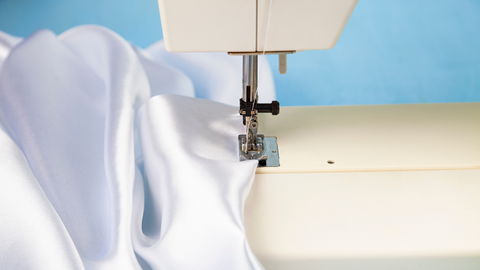
9 Tips For Sewing With Satin Fabric | All you need to know
Satin fabric is popular for a wide variety of purposes. It’s the perfect choice for formal or special occasions, and it can even be used to create a fun craft project or something more meaningful like a quilt.
However, satin can be tricky to work with and requires extra care.
What is Satin Fabric?

Satin is a type of fabric that has a shiny and smooth surface. It’s usually made from silk, rayon, or cotton and is suitable for various purposes like clothing, wedding dresses, quilts, crafts, drapes and more.
Satin fabric does require extra care to maintain its shiny appearance because it has no stretch in the material. However, it can be durable and hold up well as long as it’s cared for properly.
What You Need To Know Before Sewing With Satin

Before you start sewing with satin, there are a few things that you’ll need to know. Satin is delicate and needs to be handled carefully.
Four things to keep in mind are:
- You should always use pins when sewing with satin fabric.
- Since satin is transparent, it can be tricky to see what your project looks like. For this reason, it is recommended that you set up your sewing machine with the reverse button turned on before beginning work.
- When it comes time for pressing, make sure that you don’t put any pressure on the fabric or you risk damaging the stitching of your project.
- Satin does not fray, so tying a knot at the end of your thread will only damage your project and make it less durable.
If these pointers help, try out some of these tips for sewing with satin to create something amazing!
Preparing Your Pattern For Satin Fabric
If you’re planning to sew with satin fabric, the first step is to prepare your pattern. If your pattern doesn’t come with instructions for sewing on satin, this tip will help you.
You can purchase a pre-printed or printed pattern that includes instructions for sewing on satin fabric. It also helps if you purchase a pattern that already has the edges of the material sewn down.
If you don’t want to spend money on a pre-printed or printed pattern, start by cutting out your normal pattern pieces. Then place them on top of an old sheet and use pins to mark where they need to be cut out again. Make sure to leave at least one inch of fabric on all sides so that there’s enough room for sewing later. Once your pieces have been marked, cut them out and discard the excess material from around the edge of each piece before tacking it down with a few stitches so it doesn’t move around during sewing.
Tips For Sewing With Satin Fabric

In order to get the best results, there are certain things you need to consider.
For example,
You want to make sure that your fabric is clean and doesn’t have any wrinkles or creases in it. It's also important to use a matching thread.
You can also use a foot pedal-operated sewing machine instead of a hand one so you don't have to constantly stop and adjust the tension.
As for how much satin fabric you need, this will depend on what project you're creating. If you will be using it to make a dress, you're going to need at least two to three yards. If it's a smaller project like an accent pillow or lampshade, half a yard will be sufficient.
For projects that need more than 2 yards of fabric, keep in mind that the satin is only 54" wide, so once you start reaching the 2-yard mark, some of the widths will not be usable and may even fall off into your project.
How To Finish And Care For Your Project

- It is important to use pins, not needles when sewing satin fabric. Needles can tear the delicate fabric and cause problems.
- Use a drop of super glue to attach your satin pieces together for a stronger bond.
- You can also use a safety pin or one of its variations to help you hold pieces together while you sew them with a zigzag stitch or overcasting stitch (these are both symmetrical stitches).
- To prevent fraying, iron your stitching before and after sewing so that it doesn’t travel into the seam allowance or come undone due to moisture in the air during the ironing process.
- Satin fabrics should always be pressed before being used for any project that will be handled by people other than yourself because they are fragile and could rip easily at the seams if they aren’t pressed properly.
- If your project is going to be washed regularly, make sure to press it every time you wash it so that it keeps its shape and remains strong through many washes; otherwise, it could become misshapen or fragile with each wash cycle.
- Always use starch when pressing your fabric after washing--this helps keep the fabric from becoming limp and having more wrinkles as well as giving it a more even sheen throughout its surface area.
- Make sure that all seams are pressed open and then topstitched at least 1/4" from the edge so that your buttonholes and zipper casing allowances don't get caught up in the gathers at the seams.
- It's a good idea to put a clean piece of paper under the leg you are going to press to prevent damage from heat--this will help you avoid burns and keep your fabrics from getting creased from sitting on top of each other when pressing multiple pieces at once.
Hope this article helped you in many ways and you will keep in mind the tips we have shared.
You can also go through our guide on How to take care of your Satin Fabric
